Hunting fallow deer for venison
by Anton Jurasovic
Hunter 2
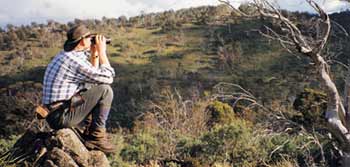 Many people hunt fallow deer for a set of trophy antlers. They relish the challenge of pitting their skills against a wily stag that may have outwitted many hunters in the past, only to grow big and wise with age. Trophy hunting is a worthy pursuit, yet even die-hard trophy hunters rarely waste the venison from that big stag they may be fortunate enough to take. For many deer hunters, myself included, the venison that is part and parcel of trophy hunting is a much valued and anticipated reward in itself.
Many people hunt fallow deer for a set of trophy antlers. They relish the challenge of pitting their skills against a wily stag that may have outwitted many hunters in the past, only to grow big and wise with age. Trophy hunting is a worthy pursuit, yet even die-hard trophy hunters rarely waste the venison from that big stag they may be fortunate enough to take. For many deer hunters, myself included, the venison that is part and parcel of trophy hunting is a much valued and anticipated reward in itself.
Venison from fallow deer has a fine reputation as a gourmet quality product. Unfortunately, many hunters are not aware that careful selection and handling is required to produce high quality meat. I know of many people who consider fallow venison to be very ordinary because they sampled meat that was poorly handled and processed or cooked inappropriately. Throughout many years of harvesting and processing deer for the table, I have learned a lot of lessons about how to ensure the best likelihood of enjoying a high quality meal at the end of the process.
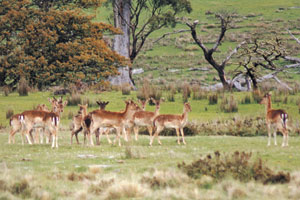
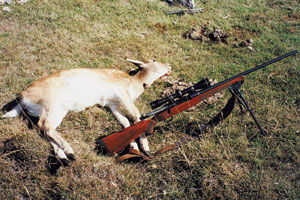 Finding fallow deer
Finding fallow deer
Fallow deer are found in ‘huntable’ numbers in southern Queensland, New South Wales, South Australia and Tasmania. Most fallow are located on private land and access rights are usually fiercely guarded. Gaining access to an area where they may be hunted can be quite difficult.
There are quite a few areas of public land in Tasmania that hold deer, but the population density is low and the terrain steep, thick and rough. One option for those who have trouble gaining access to private deer habitat is to contact one or more of the professional deer guides operating in fallow deer areas. Many of them conduct venison hunts at very reduced rates.
Having secured access to a property that holds deer, it is wise to hunt at the correct time of year to gain the best venison. Stags are easiest to hunt during the rut, but the meat can be tainted and have a strong, rank flavour. For the hunter who wants to combine trophy hunting with securing venison, the best time to hunt is the month before the rut (which is more or less in March). The antlers will be hard and the beast will be in its prime, having laid on a large amount of fat to tide it over the rut.
Selecting the right deer
If venison is the only goal of the hunt, then, where deer numbers are reasonable, it is much better to select a doe. This reduces pressure on the stags, allowing young animals to mature into a trophy. Does are best harvested during the winter months. Fawns are born in October/November and are weaned by about April. During the period that fawns are at foot, it is not very ethical to shoot the mother, as the fawn will most likely die also. On top of that, the does are in their poorest condition while the fawns are suckling. By May or June, the does are putting weight back on their frames rapidly and are in peak condition to produce quality venison from that time until September.
It is well known that the best venison comes from young deer. Spikers and first-year stags produce flavoursome, tender meat and it is easy to tell by the headgear whether they are in fact a prime, young beast. A young doe produces venison that is just as good, but it is harder to define how old a doe is when lining up on it in the field. In my home state of Tasmania, it is illegal to shoot a spiker, but elsewhere it appears to be a common practice when hunters are after venison. Personally, I prefer to leave male deer to mature and spend the time to pick out a young doe for eating. The best doe to choose for venison is a maiden doe, which will usually be one to one and a half years of age. When a herd is located, the maiden does can be picked out by their slightly smaller body size and the fact that they have a slightly shorter face than a mature doe. If the deer are undisturbed and the hunter has the opportunity to study them for a while, it soon becomes second nature to pick out the young does from the older ones.
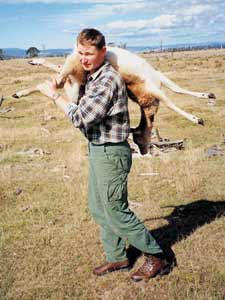 Shot placement
Shot placement
Once the hunter is lining up on a carefully selected deer, it is critical to consider shot placement to minimise damage to the meat on the front end of the animal.
When hunting for venison, it is best to aim just slightly behind the shoulder and just above centre. This shot puts the projectile through the lungs, but does not usually damage the shoulder meat. If the deer is undisturbed, this shot will normally drop it in its tracks, but occasionally they may run a short distance.
It is very important that the shot kills the deer quickly to prevent an adrenaline surge, which will result in tough venison. Lung shots are by far preferred. Head and neck/spine shots will give the desired result also, but the target in each case is small, with little margin for error. Heart shots sound good, but I avoid them because the deer will usually run a fair way after such a hit and end up full of adrenaline. Any situation where a deer is hit poorly and requires follow-up shots will almost certainly end up producing second-rate venison, so careful consideration of whether the shot is a sure one should be made before pulling the trigger.
Selecting the right ammunition
The correct selection of cartridge and projectile are necessary to ensure the quick kill required to produce high-quality venison. Fallow deer are not a particularly large animal, although they are fairly tough for their size. I consider a cartridge similar to a .243 with 100-grain projectiles to be a minimum, but I would recommend a calibre with a bit more hitting power and ranging ability to ensure the fast knockdown that is needed. There are an enormous number of suitable cartridges available. Some of the more common ones seen in fallow areas are the 6.5x55, 7x57, .270, .308 and .30-06. Any of these, plus a host of other rounds of similar performance, would be ideal.
A good controlled expansion projectile in the mid-weight range for the calibre is the best choice for fallow. Light, frangible projectiles are not recommended due to their inconsistency. I have witnessed spectacular, instant kills when this style of projectile slips between the ribs and explodes inside the chest cavity, but likewise, I have also seen them blow up on the shoulder and create little more than a flesh wound.
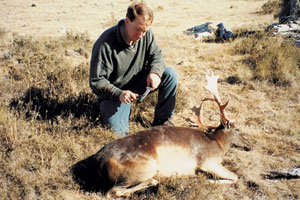
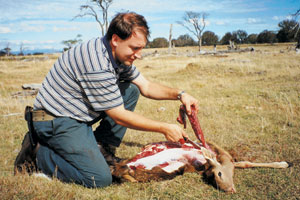 Preparing the carcass
Preparing the carcass
Once the deer is on the ground, the most pressing task at hand is to cool the carcass quickly to prevent the early onset of spoilage. The best way to do this is to immediately gut the animal and then hang it in a shady and breezy spot, with its body cavity propped open to allow air to circulate freely. It is imperative at this stage to keep the meat clean and not to spill any bacteria-laden gut juices on the carcass. Any such contamination will shorten the time that the animal can be aged, resulting in less tender meat.
I always leave the skin on during the field dressing stage, as it is good protection against dirt and flies. A cloth bag large enough to cover the whole beast is useful to stop flies accessing the body cavity. Alternatively, if you are out in the backblocks without a bag, the body cavity can be packed tightly with ferns or some other handy plant and, if done thoroughly, this will keep flies out for a few hours or so. Always remember, if the deer is a trophy and you want to mount it, do not continue the belly cut past the start of the ribcage or the cape will be ruined.
Processing the meat
Once your deer is at home, the final processing stage can begin. One of the most important aspects of producing tender, juicy venison is the ageing process. The deer is hung in a cool place and protected from flies by either putting it in a fly-proof room or completely covering it with a large cloth bag. It may be skinned before hanging, but I often leave the skin in place, as it is added protection and the outer layer of the meat does not dry out as much while hanging.
The ageing process allows the natural enzymes within the muscle tissue to begin breaking down the meat’s fibrous structure. Generally, the longer the meat is aged, the more tender it will be. In effect, the meat is allowed to slightly decompose, but not to the point that bacteria invade and make it inedible. Most often the deer will be hung whole, but I have had good success with separated legs as well.
The length of time a carcass can be aged depends on the ambient temperature it is exposed to and how clean it was kept during the field-processing stage. Where I live, it is possible to hang a carcass for five to six days ‘under the house’ in winter and not have a hint of the odour that indicates the meat is beginning to go off. In March, when we have our stag season, I am only able to hang the meat for three or four days. I’ve found that as soon as I can detect the slightest tainted smell from a good sniff in the body cavity, it is time to carve up the carcass and freeze it promptly. If you are lucky enough to have access to a chiller in which to hang your beast, then the ageing process can sometimes be stretched out to as long as ten days, which usually results in fantastic venison.
Selecting the best cuts
When it’s time to butcher the carcass, I stick with fairly simple methods. My preference is to fillet all the meat off the bone and then proceed to turn these large pieces into roasts, steaks, cubes and such. It is possible to remove the meat off the shoulder blade in one piece and this makes a great ‘rolled’ roast. The other cut I use for roasting is the meat off the thigh, although the meat from this area also makes good steaks when cut perpendicular to the axis of the bone. The back straps are the choicest meat on the deer and butterfly steaks from this cut are delicious. Meat from the back straps can also be cubed or cut into strips to form the basis of dishes such as stroganoff or any Asian stir-fry.
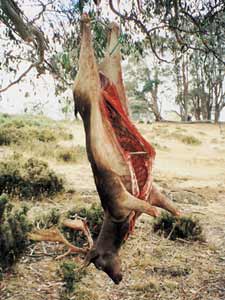 Cooking venison
Cooking venison
Venison is a relatively dry meat. It does not have fat ‘marbled’ through the muscle like some domestic species. Because of this, when cooking, the best results come from using it in dishes that either conserve what moisture there is or are cooked and served with a sauce. A game cookery book is a good investment, but there are many beef recipes that taste great when substituted with venison. For example, when roasting, a good choice is a recipe where the meat is pastry covered, like Beef Wellington. A favourite of mine is a fruited pot roast, where the meat is roasted in a covered pot with apple juice and surrounded by various fruits.
Steaks need to either be cooked ‘rare’ to conserve the juices or bread crumbed like schnitzel. When stir frying, as with other meats, the cubes or strips need to be quickly browned all over to seal in the juices. Venison cooked in any of a number of spaghetti sauces and served with pasta can be delicious. The possibilities are almost endless and a little forethought about whether the recipe will keep the meat moist is all that’s needed.
Following these relatively simple guidelines should result in delicious venison meals. In my experience, there is no better feeling than serving up the food of royalty to friends or family and then being able to say that you processed it from ‘go to whoa’. So good hunting and enjoy the venison.
Captions
Image 1: Glassing from a good vantage point is one of the best ways to find fallow deer.
Image 2: The deer to choose for venison from this group is the maiden doe, second from the right. It can be recognised by its slightly smaller body size and shorter face.
Image 3: A maiden doe taken cleanly with the author’s Winchester Featherweight in .270 calibre. Young does, like this one, provide excellent venison.
Image 4: Carrying a carcass out whole so it can be hung in one piece is hard work - even if it is only a young doe like this one.
Image 5: Trophy hunting has the added bonus of quality venison if undertaken before the rut. This stag has just stripped its velvet and is in prime condition.
Image 6: Boning meat from a doe in the field. Tender back-straps from a young animal often don’t need ageing. Separated legs can still be hung to age with great success.
Image 7: It is very important to cool the carcass quickly after harvest. Prompt gutting and hanging in the shade with the body cavity propped open ensures the meat will cool rapidly.
